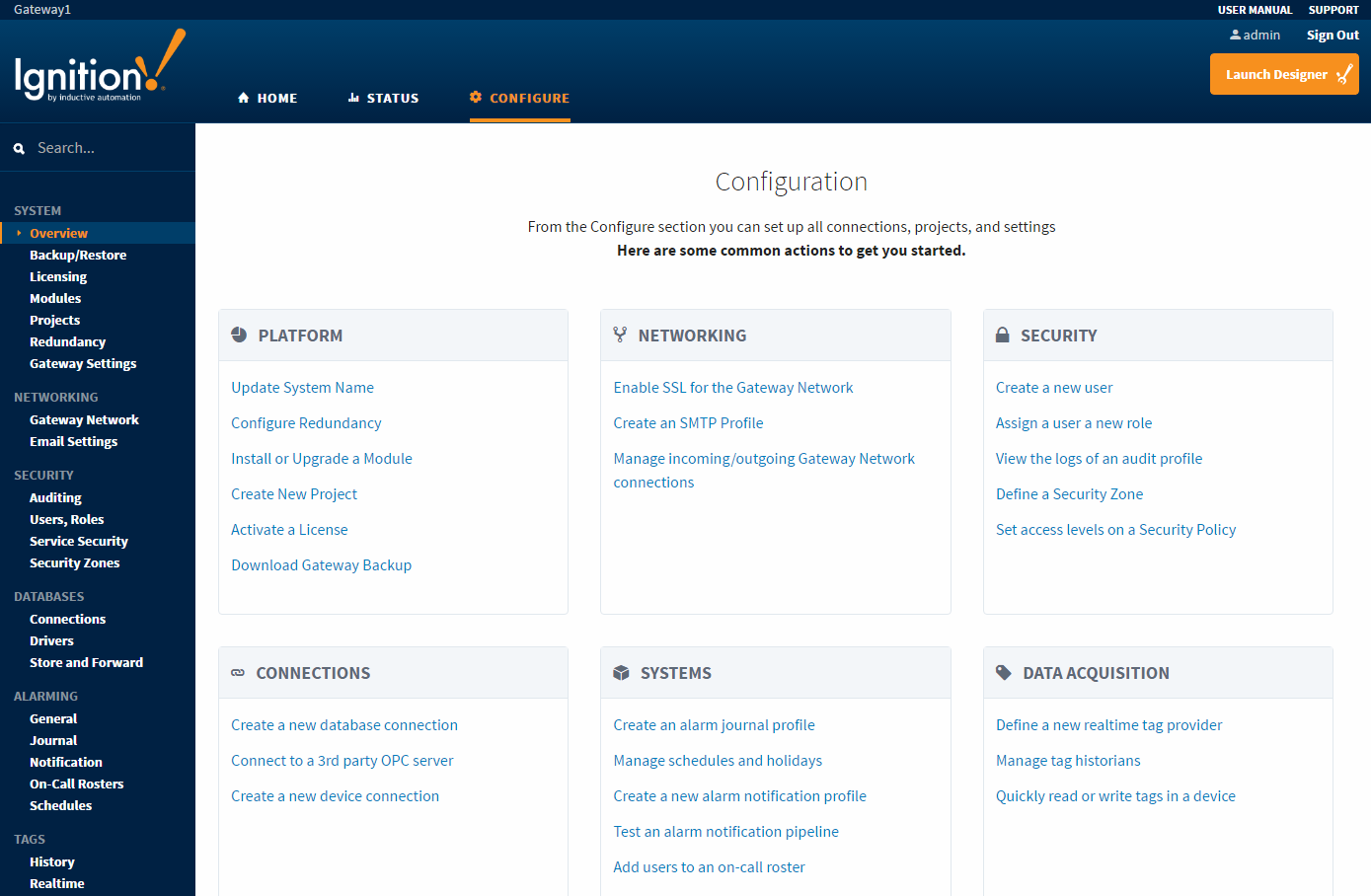Configuring the Gateway
The Configure tab provides access to configuration options for gateway settings. Here we can adjust the settings for alarming, add users and roles, or even setup a gateway backup to be taken automatically at specific times. This is where most of the settings that affect the whole Gateway will be setup.
System
The System section is a sort of catch all section that can do a lot of different things. The first window is the Overview page, which is what will first show up when navigating to the Configure tab. The Overview page only has links to other sections of the Configure tab, but it is useful if you aren't exactly sure where the setting you are looking for is located, because the Overview page lists the most common configuration changes.

Backup/Restore
The Backup/Restore page is where you can manually take a backup and restore a previous backup. It also can upgrade a legacy backup.
Licensing
The Licensing page allows you to control any and all licenses currently activated on the gateway. It will show all the modules that the license is currently good for, and have some options for activating a new or additional license.
Modules
The Modules page displays all currently installed modules and if they are active or not.
Projects
The Projects page can easily manage all of the projects currently configured in the gateway, with settings that change the Name and Title, or the default database and authentication profile of the project.
Redundancy
The Redundancy page is where all of Ignition's redundancy settings are configured. This is where the master and backup nodes are configured as well as the network settings to make sure the two nodes can properly communicate.
Gateway Settings
The Gateway Settings page is where all miscellaneous settings are located. Autobackups can be configured here to happen at certain times. SSL encryption can be turned on here as well as changing roles required to access certain parts of the Gateway for increased security.
Networking
The Networking section deals with setup and management of the Gateway Network. Here the Gateway's connection settings can be changed to only allow certain connections, and connections to other Gateways can be setup as well.
Security
The Security section is where User Sources are setup with users and roles. It is also where auditing is setup to track project changes, as well as the Gateway Network's Security Zones.
Databases
The Databases section is where a database connection can be setup. It is also where to configure and import the JDBC drivers used in database connections, as well as adjusting the Store and Forward system.
Alarming
The Alarming section gives general alarm configuration as well as Alarm Journal setup. While alarms are configured on individual tags, the Journal won't record alarm events unless an alarm journal has been setup in the gateway. The Notification Profiles are configured in the Alarming section to allow for notifications to be sent out when an alarm event has occured, as well as On-Call Rosters which determine who to send the notification to. Finally, Ignition's User Schedules is also configured in the alarming section which can be setup to restrict certain users from accessing parts of Ignition when it is not their scheduled time.
Tags
The Tags section is where both Realtime Tag Providers as well as Historical Tag Providers are configured. It is NOT where individual tags are setup.
OPC-UA Server
The OPC-UA Server is where Ignition's internal OPC-UA server is configured. The Devices page is where all device connections to our internal OPC-UA server are setup as well.
OPC Connections
The OPC Connections section is where connections from Ignition's internal OPC-UA server to other OPC servers are
Mobile
The Mobile section provides some options for configuring mobile clients. Everything from the max number of mobile clients at one time to the max memory the mobile clients will use can be set here.
Enterprise Administration
The Enterprise Administration section controls the majority of EAM functions. Setting the Gateway to be a Controller or Agent as well as creating Agent Tasks and managing the various Agents from the Controller Gateway can all be done in this section.